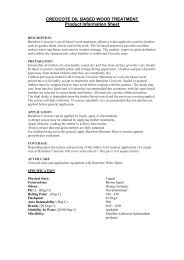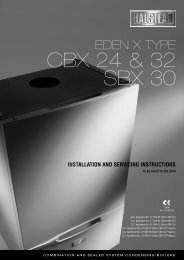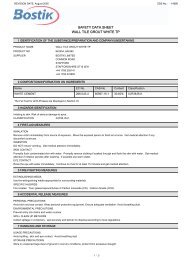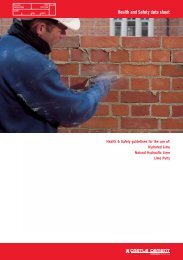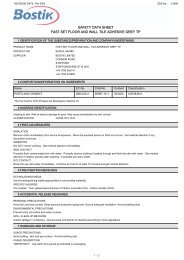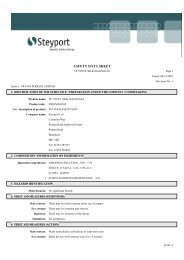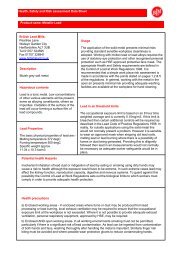SAFETY DATA SHEET TRAVIS PERKINS PATENT KNOTTING
SAFETY DATA SHEET TRAVIS PERKINS PATENT KNOTTING
SAFETY DATA SHEET TRAVIS PERKINS PATENT KNOTTING
Create successful ePaper yourself
Turn your PDF publications into a flip-book with our unique Google optimized e-Paper software.
REVISION DATE: 09/08/2010<br />
<strong>SAFETY</strong> <strong>DATA</strong> <strong>SHEET</strong><br />
<strong>TRAVIS</strong> <strong>PERKINS</strong> <strong>PATENT</strong> <strong>KNOTTING</strong><br />
1 IDENTIFICATION OF THE SUBSTANCE/PREPARATION AND OF THE COMPANY/UNDERTAKING<br />
PRODUCT NAME<br />
SUPPLIER<br />
APPLICATION<br />
<strong>TRAVIS</strong> <strong>PERKINS</strong> <strong>PATENT</strong> <strong>KNOTTING</strong><br />
Bartoline Limited<br />
Barmston Close<br />
Beverley<br />
East Yorkshire<br />
HU17 0LW<br />
Tel. 01482 678710<br />
Fax 01482 872606<br />
HSE Manager<br />
Email info@bartoline.co.uk<br />
EMERGENCY TELEPHONE 01482 678727 0800-1700<br />
2 HAZARDS IDENTIFICATION<br />
FOR SEALING KNOTS IN TIMBER PRIOR TO OVER PAINTING.<br />
Highly flammable. Harmful by inhalation, in contact with skin and if swallowed. Harmful: possible risk of irreversible effects through<br />
inhalation, in contact with skin and if swallowed.<br />
CLASSIFICATION (1999/45) Xn;R20/21/22, R68/20/21/22. F;R11.<br />
3 COMPOSITION/INFORMATION ON INGREDIENTS<br />
Name EC No. CAS-No. Content Classification (67/548)<br />
ETHANOL<br />
200-578-6<br />
64-17-5 60-100%<br />
F;R11<br />
METHANOL<br />
200-659-6<br />
67-56-1 1-5%<br />
F;R11 T;R23/24/25,R39/23/24/25<br />
The Full Text for all R-Phrases are Displayed in Section 16<br />
COMPOSITION COMMENTS<br />
This product is a mixture of Alcohol soluble natural resin conbined with Ethanol and methanol.<br />
4 FIRST-AID MEASURES<br />
GENERAL INFORMATION<br />
NOTE! Keep affected person away from heat, sparks and flames! Move the exposed person to fresh air at once. Get medical attention if<br />
any discomfort continues.<br />
INHALATION<br />
Move the exposed person to fresh air at once. For breathing difficulties oxygen may be necessary. If breathing stops, provide artificial<br />
respiration. Keep the affected person warm and at rest. Get prompt medical attention.<br />
INGESTION<br />
DO NOT INDUCE VOMITING! Remove victim immediately from source of exposure. Rinse mouth thoroughly. Provide rest, warmth and<br />
fresh air. Get medical attention immediately! If vomiting occurs, keep head low so that stomach content doesn't get into the lungs.<br />
SKIN CONTACT<br />
Remove affected person from source of contamination. Remove contaminated clothing. Wash the skin immediately with soap and water.<br />
Get medical attention if irritation persists after washing.<br />
EYE CONTACT<br />
Make sure to remove any contact lenses from the eyes before rinsing. Promptly wash eyes with plenty of water while lifting the eye lids.<br />
Continue to rinse for at least 15 minutes. Contact physician if irritation persists.<br />
5 FIRE-FIGHTING MEASURES<br />
1 / 5
REVISION DATE: 09/08/2010<br />
EXTINGUISHING MEDIA<br />
Extinguish with alcohol-resistant foam, carbon dioxide or dry powder.<br />
SPECIAL FIRE FIGHTING PROCEDURES<br />
<strong>TRAVIS</strong> <strong>PERKINS</strong> <strong>PATENT</strong> <strong>KNOTTING</strong><br />
Avoid breathing fire vapours. Cool containers exposed to flames with water until well after the fire is out. Keep run-off water out of sewers<br />
and water sources. Dike for water control.<br />
UNUSUAL FIRE & EXPLOSION HAZARDS<br />
HIGHLY FLAMMABLE! May explode when heated or when exposed to flames or sparks. May travel considerable distance to source of<br />
ignition and flash back.<br />
SPECIFIC HAZARDS<br />
The product is flammable, and heating may generate vapours which may form explosive vapour/air mixtures. Considering the size of the<br />
packaging, the risk is regarded as minimal.<br />
PROTECTIVE MEASURES IN FIRE<br />
Self contained breathing apparatus and full protective clothing must be worn in case of fire.<br />
6 ACCIDENTAL RELEASE MEASURES<br />
PERSONAL PRECAUTIONS<br />
Wear protective clothing as described in Section 8 of this safety data sheet. Follow precautions for safe handling described in this safety<br />
data sheet. Take precautionary measures against static discharges. In case of spills, beware of slippery floors and surfaces.<br />
ENVIRONMENTAL PRECAUTIONS<br />
Do not allow ANY environmental contamination. Spillages or uncontrolled discharges into watercourses must be IMMEDIATELY alerted to<br />
the Environmental Agency or other appropriate regulatory body.<br />
SPILL CLEAN UP METHODS<br />
Extinguish all ignition sources. Avoid sparks, flames, heat and smoking. Ventilate. Clean-up personnel should use respiratory and/or<br />
liquid contact protection. Absorb in vermiculite, dry sand or earth and place into containers. Ensure that waste and contaminated<br />
materials are collected and removed from the work area as soon as possible in a suitably labelled container<br />
7 HANDLING AND STORAGE<br />
USAGE PRECAUTIONS<br />
Avoid spilling, skin and eye contact. Keep away from heat, sparks and open flame. Ventilate well, avoid breathing vapours. Use<br />
approved respirator if air contamination is above accepted level. Use explosion proof electric equipment.<br />
USAGE DESCRIPTION<br />
Keep containers closed when not in use. Apply by brush<br />
STORAGE PRECAUTIONS<br />
Flammable/combustible - Keep away from oxidisers, heat and flames. Store in tightly closed original container in a dry and cool place.<br />
Keep in original container.<br />
STORAGE CLASS<br />
Flammable liquid storage.<br />
8 EXPOSURE CONTROLS/PERSONAL PROTECTION<br />
Name<br />
Std<br />
TWA - 8 hrs<br />
STEL - 15 min<br />
Notes<br />
ETHANOL<br />
MEL<br />
1000 ppm 1920 mg/m3<br />
METHANOL WEL 200 ppm 266<br />
250 ppm 333<br />
Sk<br />
mg/m3(Sk)<br />
mg/m3(Sk)<br />
WEL = Workplace Exposure Limit.<br />
Sk = Can be absorbed through skin.<br />
INGREDIENT COMMENTS<br />
WEL = Workplace Exposure Limits<br />
PROTECTIVE EQUIPMENT<br />
2 / 5
REVISION DATE: 09/08/2010<br />
ENGINEERING MEASURES<br />
Provide adequate general and local exhaust ventilation.<br />
RESPIRATORY EQUIPMENT<br />
<strong>TRAVIS</strong> <strong>PERKINS</strong> <strong>PATENT</strong> <strong>KNOTTING</strong><br />
Respiratory protection must be used if air contamination exceeds acceptable level.<br />
HAND PROTECTION<br />
Protective gloves should be used if there is a risk of direct contact or splash. Nitrile gloves are recommended, but be aware that the liquid<br />
may penetrate the gloves. Frequent change is advisable.<br />
EYE PROTECTION<br />
If risk of splashing, wear safety goggles or face shield.<br />
OTHER PROTECTION<br />
Wear appropriate clothing to prevent any possibility of liquid contact and repeated or prolonged vapour contact.<br />
HYGIENE MEASURES<br />
DO NOT SMOKE IN WORK AREA! Wash at the end of each work shift and before eating, smoking and using the toilet. Wash promptly<br />
with soap & water if skin becomes contaminated. Promptly remove any clothing that becomes contaminated. Use appropriate skin cream<br />
to prevent drying of skin. When using do not eat, drink or smoke.<br />
9 PHYSICAL AND CHEMICAL PROPERTIES<br />
APPEARANCE<br />
COLOUR<br />
ODOUR<br />
SOLUBILITY<br />
Coloured liquid<br />
Brown<br />
Characteristic<br />
Insoluble in water<br />
BOILING POINT (°C) Not determined RELATIVE DENSITY 0.85<br />
VAPOUR PRESSURE 58 mbar 20 EVAPORATION RATE 0.75 (nBut Ac = 1)<br />
VISCOSITY 4.5 mPas 20 FLASH POINT (°C) 12 degrees C<br />
AUTO IGNITION<br />
420 FLAMMABILITY LIMIT - LOWER(%) 4.3<br />
TEMPERATURE (°C)<br />
FLAMMABILITY LIMIT - UPPER(%) 19 VOLATILE ORGANIC COMPOUND<br />
(VOC)<br />
625g/l<br />
10 STABILITY AND REACTIVITY<br />
STABILITY<br />
Stable under normal temperature conditions.<br />
CONDITIONS TO AVOID<br />
Avoid heat, flames and other sources of ignition.<br />
HAZARDOUS POLYMERISATION<br />
Unknown.<br />
MATERIALS TO AVOID<br />
Strong oxidising substances. Strong acids.<br />
HAZARDOUS DECOMPOSITION PRODUCTS<br />
Fire creates: Toxic gases/vapours/fumes of: Carbon monoxide (CO). Carbon dioxide (CO2).<br />
11 TOXICOLOGICAL INFORMATION<br />
GENERAL INFORMATION<br />
Prolonged and repeated contact with solvents over a long period may lead to permanent health problems.<br />
INHALATION<br />
Vapours may cause headache, fatigue, dizziness and nausea. Vapour may irritate respiratory system or lungs.<br />
INGESTION<br />
Pneumonia may be the result if vomited material containing solvents reaches the lungs. Narcotic effect.<br />
SKIN CONTACT<br />
Acts as a defatting agent on skin. May cause cracking of skin, and eczema. Prolonged or repeated exposure may cause severe irritation.<br />
EYE CONTACT<br />
Irritating to eyes. Vapour or spray may cause temporary (reversible) eye damage.<br />
ROUTE OF ENTRY<br />
Inhalation. Ingestion. Skin and/or eye contact.<br />
3 / 5
REVISION DATE: 09/08/2010<br />
TARGET ORGANS<br />
Respiratory system, lungs. Liver. Skin.<br />
MEDICAL SYMPTOMS<br />
<strong>TRAVIS</strong> <strong>PERKINS</strong> <strong>PATENT</strong> <strong>KNOTTING</strong><br />
High concentrations of vapours may irritate respiratory system and lead to headache, fatigue, nausea and vomiting.<br />
12 ECOLOGICAL INFORMATION<br />
ECOTOXICITY<br />
The product is mildly toxic to aquatic organisms.<br />
BIOACCUMULATION<br />
Negligible due to high volatility of carrier solvent resulting in rapid evaporation to air. Resin is based on naturally derived materials subject<br />
to slow degregation in the environment.<br />
ACUTE FISH TOXICITY<br />
This product is a marine pollutant and should not be discharged into watercourses<br />
13 DISPOSAL CONSIDERATIONS<br />
GENERAL INFORMATION<br />
Rags and the like, moistened with flammable liquids, must be discarded into designated fireproof bucket. When handling waste,<br />
consideration should be made to the safety precautions applying to handling of the product. Waste is classified as hazardous waste.<br />
Disposal to licensed waste disposal site in accordance with the local Waste Disposal Authority.<br />
DISPOSAL METHODS<br />
Dispose of waste and residues in accordance with local authority requirements. Empty containers must not be burned because of explosion<br />
hazard. Used empty containers can be left to set hard and dissposed of as non hazardous waste. Incinerate in suitable combustion<br />
chamber.<br />
WASTE CLASS<br />
EU Waste Catalogue Code 20 01 27 Paint, inks, adhesives and resins containing dangerous substances.<br />
14 TRANSPORT INFORMATION<br />
UK ROAD CLASS 3<br />
PROPER SHIPPING NAME<br />
ROAD TRANSPORT NOTES<br />
PAINT<br />
Limited quantity size 5 litres<br />
UN NO. ROAD<br />
ADR CLASS NO.<br />
ADR PACK GROUP<br />
1263<br />
3<br />
II<br />
UK ROAD PACK GR.<br />
ADR CLASS<br />
TUNNEL RESTRICTION CODE<br />
HAZARD No. (ADR) 33<br />
ADR LABEL NO.<br />
3<br />
RID CLASS NO.<br />
3<br />
RID PACK GROUP<br />
UN NO. SEA 1263<br />
IMDG CLASS<br />
3<br />
IMDG PACK GR.<br />
II<br />
UN NO. AIR 1263<br />
AIR CLASS<br />
3<br />
AIR PACK GR.<br />
15 REGULATORY INFORMATION<br />
II<br />
EMS<br />
II<br />
Class 3: Flammable liquids.<br />
(D/E)<br />
II<br />
F-E, S-E<br />
LABELLING<br />
4 / 5
REVISION DATE: 09/08/2010<br />
<strong>TRAVIS</strong> <strong>PERKINS</strong> <strong>PATENT</strong> <strong>KNOTTING</strong><br />
Harmful<br />
Highly Flammable<br />
CONTAINS<br />
METHANOL<br />
RISK PHRASES<br />
<strong>SAFETY</strong> PHRASES<br />
UK REGULATORY REFERENCES<br />
R11<br />
R20/21/22<br />
R68/20/21/22<br />
Highly flammable.<br />
Harmful by inhalation, in contact with skin and if swallowed.<br />
Harmful: possible risk of irreversible effects through inhalation, in contact with skin and if<br />
swallowed.<br />
S1/2 Keep locked up and out of the reach of children.<br />
S7<br />
S16<br />
S29<br />
Keep container tightly closed.<br />
Keep away from sources of ignition - No smoking.<br />
Do not empty into drains.<br />
S36/37 Wear suitable protective clothing and gloves.<br />
S45<br />
S56<br />
In case of accident or if you feel unwell, seek medical advice immediately (show label<br />
where possible).<br />
Dispose of this material and its container to hazardous or special waste collection point.<br />
Fire precautions Act 1971. Highly Flammable Liquid Regulations 1972. Health and Safety at Work Act 1974. The Control of Substances<br />
Hazardous to Health Regulations 1988. Chemicals (Hazard Information & Packaging) Regulations. Article 4 of Directive 2004/42/EC on<br />
the limitation of emissions of volatileorganiv compounds due to the use of organic solvents in paints and varnishes indicates that prodcuts<br />
set out in Annex I must carry a label indicating: The sub category of the product and the relevant VOC limit value in g/l as referred to in<br />
annex II; the maximum content content of VOC in g/l of the product in a ready to use condition.<br />
ENVIRONMENTAL LISTING<br />
Control of Pollution Act 1974.<br />
EU DIRECTIVES<br />
Dangerous Preparations Directive 1999/45/EC. Regulation (EC) No 1907/2006 of the European Parliament and of the Council of 18<br />
December 2006 concerning the Registration, Evaluation, Authorisation and Restriction of Chemicals (REACH), establishing a European<br />
Chemicals Agency, amending Directive 1999/45/EC and repealing Council Regulation (EEC) No 793/93 and Commission Regulation (EC)<br />
No 1488/94 as well as Council Directive 76/769/EEC and Commission Directives 91/155/EEC, 93/67/EEC, 93/105/EC and 2000/21/EC,<br />
including amendments. VOC - EU Limit value for this product (catA/h) :759g/l (2007) 750g/l (2010) This product contains max 625g.l VOC.<br />
STATUTORY INSTRUMENTS<br />
Chemicals (Hazard Information and Packaging) Regulations. Control of Substances Hazardous to Health.<br />
APPROVED CODE OF PRACTICE<br />
Classification and Labelling of Substances and Preparations Dangerous for Supply.<br />
GUIDANCE NOTES<br />
Workplace Exposure Limits EH40. Introduction to Local Exhaust Ventilation HS(G)37. CHIP for everyone HSG(108).<br />
16 OTHER INFORMATION<br />
REVISION DATE 09/08/2010<br />
REV. NO./REPL. SDS GENERATED 1<br />
RISK PHRASES IN FULL<br />
R11<br />
R23/24/25<br />
R39/23/24/25<br />
Highly flammable.<br />
Toxic by inhalation, in contact with skin and if swallowed.<br />
Toxic: danger of very serious irreversible effects through inhalation, in contact with skin and if swallowed.<br />
DISCLAIMER<br />
The information contained in this data sheet is provided in accordance with the requirements of the Chemicals (Hazard Information and Packaging for<br />
Supply) Regulations. The product should not be used for purposes other than those shown in Section 1. As the specific conditions of use are outside the<br />
suppliers control, the user is responsible for ensuring that the requirements of relevant legislation are complied with. The information contained in this<br />
safety data sheet is based on the present knowledge and the current UK legislation and EC Directive 91/155EC. It provides guidance on health, safety<br />
and environmental aspects of the product and should not be taken as a product specification.<br />
5 / 5






